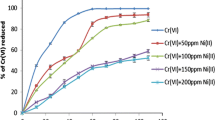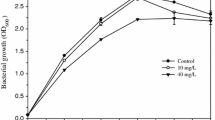Abstract
Bioreduction of the very toxic hexavalent chromium ion [Cr(VI)] to the non-toxic trivalent chromium ion [Cr(III)] is a key remediation process in chromium-contaminated sites. In this study, we investigated the bioreduction of Cr(VI) by Pseudomonas stutzeri L1 and Acinetobacter baumannii L2. The optimum pH (5–10), temperature (27, 37 and 60 °C) and initial chromium Cr(VI) concentration (100–1000 mg L−1) for Cr(VI) reduction by strains L1 and L2 were determined using the diphenylcarbazide method. In the presence of L1 and L2, the bioreduction rate of Cr(VI) was 40–97 and 84–99%, respectively. The bioreduction of Cr(VI) by L2 was higher, reaching up to 84%—than that by L1. The results showed that strain L2 was able to survive even if exposed to 1000 mg L−1 of Cr(VI) and that this tolerance to the effects of Cr(VI) was linked to the activity of soluble enzyme fractions. Overall, A. baumannii L2 would appear to be a potent Cr(VI)-tolerant candidate for the bioremediation of chromium (VI)-contaminated wastewater effluent.






Similar content being viewed by others
References
Adki VS, Jadhav JP, Bapat VA (2013) Nopalea cochenillifera, a potential chromium (VI) hyper accumulator plant. Environ Sci Pollut Res 20(2):1173–1180
Agostinho LS, Marcia RC, Sergio S, Patrícia TD, Renato SF, Carmen MS, Cleonice MB, Ernesto H (2012) Heavy metal tolerance (Cr, Ag and Hg) in bacteria isolated from sewage. Braz J Microbiol 43(4):1620–1631
Ahluwalia SS, Goyal D (2007) Microbial and plant derived biomass for removal of heavy metals from wastewater. Bioresour Technol 98:2243–2257
Chaturvedi MK (2011) Studies on chromate removal by chromium resistant Bacillus sp. isolated from tannery effluent. J Environ Prot 2:76–82
Cheung KH, Gu JD (2003) Reduction of chromate (CrO4) by an enrichment consortium and an isolate of marine sulfate-reducing bacteria. Chemosphere 52:1523–1529
Coata M (2003) Potential hazards of hexavalent chromate in our drinking water. Toxicol Appl Pharmacol 1:1–5
Dey S, Pandit B, Paul A (2014) Reduction of hexavalent chromium by viable cells of chromium resistant bacteria isolated from chromite mining environment. J Mining 2014:1–8
Essahale A, Malki M, Marin I, Moumni M (2012) Hexavalent chromium reduction and accumulation by acinetobacter AB1 isolated from fez tanneries in Morocco. Indian J Microbiol 52(1):48–53
Ferdouse ZT, Azizul H, Sirajul H (2016) Bacterial tolerance and reduction of chromium (VI) by Bacillus cereus isolate PGBw4. Am J Environ Prot 5(2):35–38
Field EK, Gerlach R, Viamajala S, Jennings LK, Peyton BM, Apel WA (2013) Hexavalent chromium reduction by Cellulomonas sp. strain ES6: the influence of carbon source, iron minerals and electron shuttling compounds. Biodegradation 24:437–450
Ganguli A, Tripathi AK (2001) Inducible periplasmic chromate reducing activity in Pseudomonas aeruginosa isolated from a leather tannery effluent. J Microbiol Biotechnol 11:355–361
Garbisu C, Alkorta I, Llama Maria J, Serra JL (1998) Aerobic chromate reduction by Bacillus subtilis. Biodegradation 9:133–141
Gupta VK, Rastogi A (2009) Biosorption of hexavalent chromium by raw and acid-treated green alga Oedogonium hatei from aqueous solutions. J Hazard Mater 163:396–402
Kamaludeen SPB, Megharaj M, Naidu R, Singleton I, Juhasz AL, Hawke BG, Sethunanthan N (2003) Microbial activity and phospholipid fatty acid pattern in long-term tannery waste-contaminated soil. Ecotoxicol Environ Saf 56:302–310
Masood F, Malik A (2011) Hexavalent chromium reduction by Bacillus sp. Strain FM1 isolated from heavy-metal contaminated soil. Bull Environ Contam Toxicol 86:114–119
McLean J, Beveridge TJ (2001) Chromate reduction by a pseudomonad isolated from a site contaminated with chromate copper arsenate. Appl Environ Microbiol 67:1076–1084
Megharaj M, Avudainayagam S, Naidu R (2003) Toxicity of hexavalent chromium and its reduction by bacteria isolated from soil contaminated with tannery waste. Curr Microbiol 47:51–54
MINAS-CPCB (Minimals National Standard-Central Pollution Control Board) (2011) Pollution control acts, rules, and notification there under central pollution control board. Ministry of Environment and Forests, Government of India, New Delhi
Mistry K, Desai C, Patel K (2009) Reduction of chromium (VI) by bacterial strain KK15 isolated from contaminated soil. J Cell Tissue Res 9(2):1821–1826
Mukherjee K, Nandi R, Saha D, Saha B (2015) Surfactant assisted enhancement of bioremediation rate for hexavalent chromium by water extract of Sajina (Moringa oleifera) flower. Desalin Water Treat 53(3):746–751
Naik UC, Srivastava S, Thakur IS (2012) Isolation and characterization of Bacillus cereus IST105 from electroplating effluent for detoxification of hexavalent chromium. Environ Sci Pollut Res 19:3005–3014
Naja G, Mustin C, Volesky B, Berthelin J (2005) A high resolution titrator: a new approach to studying binding sites of microbial biosorbents. Water Res 39(4):579–588
Nourbakhsh M, Sag Y, Ozer D, Aksu Z, Kutsal T, Calgar A (1994) A comparative study of various biosorbents for removal of chromium (VI) ions from industrial wastewater. Process Biochem 29:1–5
Pal A, Dutta S, Paul AK (2005) Reduction of hexavalent chromium by cell free extract of Bacillus sphaericus and 303 isolated from serpentine soil. Curr Microbiol 51:327–330
Rehman F, Faisal M (2015) Toxic hexavalent chromium reduction by Bacillus pumilis, Cellulosimicrobium cellulans and Exiguobacterium. Chin J Oceanol Limnol 33:585–589
Ross DS, Sjogren RE, Bartlett RJ (1981) Behavior of chromium in soils: IV. Toxicity to microorganisms. J Environ Qual 2:145–168
Saitou N, Nei M (1987) The neighbor-joining method: a new method for reconstructing phylogenetic trees. Mol Biol Evol 4:406–425
Sayel H, Bahafid W, Joutey NT, Derraz K, Benbrahim KF, Koraichi SI, Ghachtouli NE (2012) Cr(VI) reduction by Enterococcus gallinarum isolated from tannery waste-contaminated soil. Ann Microbiol 62:1269–1277
Soni SK, Singh R, Awasthi A, Singh M, Kalra A (2013) In vitro Cr(VI) reduction by cell-free extracts of chromate-reducing bacteria isolated from tannery effluent irrigated soil. Environ Sci Pollut Res 20:1661–1674
Stewart DI, Burke IT, Mortimer RJG (2007) Stimulation of microbially mediated chromate reduction in alkaline soil water systems. Geomicrobiol J 4:655–669
Sundar K, Vidya R, Mukherjee A, Chandrasekaran N (2010) High chromium tolerant bacterial strains from Palar River Basin: impact of tannery pollution. Res J Environ Earth Sci 2:112–117
Thacker U, Parikh R, Shouche Y, Madamwar D (2006) Hexavalent chromium reduction by Providencia sp. Proc Biochem 41:1332–1337
Thacker U, Parikh R, Shouche Y, Madamwar D (2007) Reduction of chromate by cell-free extract of Brucella sp. isolated from Cr(VI) contaminated sites. Bioresour Technol 98:1541–1547
Van Engelen MR, Peyton BM, Mormile MR, Pinkart HC (2008) Fe(III), Cr(VI), and Fe(III) mediated Cr(VI) reduction in alkaline media using a Halomonas isolate from Soap Lake, Washington. Biodegradation 19:841–850
Viti C, Giovannetti L (2001) The impact of chromium contamination on soil heterotrophic and photosynthetic microorganisms. Ann Microbiol 51:201–213
Viti C, Giovannetti L (2005) Characterization of cultivable heterotrophic bacterial communities in Cr-polluted and unpolluted soils using biolog and ARDRA approaches. Appl Soil Ecol 28:101–112
Viti C, Pace A, Giovannetti L (2003) Characterization of Cr (VI) resistant bacteria isolated from chromium contaminated soil by tannery activity. Curr Microbiol 46:1–5
Wang PC, Mori T, Toda K, Ohtake H (1990) Membrane-associated chromate reductase activity from Enterobacter cloacae. J Bacteriol 172:1670–1672
Wani PA, Zainab IO, Wasiu IA, Jamiu KO (2015) Chromium(VI) reduction by Streptococcus species isolated from the industrial area of Abeokuta, Ogun State, Nigeria. Res J Microbiol 10(2):66–75
Ye Q, Roh Y, Carroll SL, Blair B, Zhou J, Zhang CL, Fields MW (2004) Alkaline anaerobic respiration: isolation and characterization of a novel alkaliphilic and metal-reducing bacteria. Appl Environ Microbiol 70:5595–5602
Zahoor A, Rehman A (2009) Isolation of Cr(VI) reducing bacteria from industrial effluents and their potential use in bioremediation of chromium containing wastewater. J Environ Sci 21:814–820
Zayed AM, Terry N (2003) Chromium in the environment: factors affecting biological remediation. Plant Soil 249(1):139–156
Acknowledgements
This study was financially supported by Department of Biotechnology (Government of India) in the form of a Ramalingaswami re-entry Fellowship (BT/RLF/Re-entry/17/2012) and the University Grants Commission-MRP (MRP-MAJOR-MICRO-2013-31825). We thank Dr. K. Ravichandran, Associate Professor, Department of English, Thiruvalluvar University, Vellore for his assistance during manuscript preparation.
Author information
Authors and Affiliations
Corresponding author
Ethics declarations
Ethical statement
This article does not contain any studies with human participants or animals performed by any of the authors.
Conflict of interest
The authors declare that they have no conflict of interest.
Rights and permissions
About this article
Cite this article
Sathishkumar, K., Murugan, K., Benelli, G. et al. Bioreduction of hexavalent chromium by Pseudomonas stutzeri L1 and Acinetobacter baumannii L2. Ann Microbiol 67, 91–98 (2017). https://doi.org/10.1007/s13213-016-1240-4
Received:
Accepted:
Published:
Issue Date:
DOI: https://doi.org/10.1007/s13213-016-1240-4




